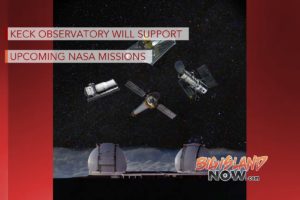NASA Awards New Cooperative Agreement to Keck Observatory
NASA announced it has awarded a five-year Cooperative Agreement with the California Association for Research in Astronomy to continue the science program at Keck Observatory.
Although it’s privately owned, NASA contributed to the observatory in 1994 and has been a partner ever since.
The W. M. Keck Observatory operates the most scientifically productive telescopes on Earth. The two, 10-meter optical/infrared telescopes on Mauna Kea’s summit feature advanced instruments including imagers, multi-object spectrographs, high-resolution spectrographs, integral-field spectrometers, and world-leading laser guide star adaptive optics systems.
“The Keck Observatory has unique, world-class capabilities that we consider essential to realize the scientific potential of many NASA missions, both ongoing and planned,” said Paul Hertz, director of the Astrophysics Division at NASA Headquarters. “NASA’s continuing partnership with Keck will ensure that astronomers and planetary scientists can carry out important ground-based observations necessary for the success of NASA missions and their scientific objectives.”
Under the new agreement, which takes effect March 1, 2018 through February 28, 2023, Keck Observatory will support the following upcoming NASA missions:
• James Webb Space Telescope
• Transiting Exoplanet Survey Satellite
• Wide Field Infrared Survey Telescope
• Euclid (ESA)
• Mars 2020
• Explorers Program: Medium-Class Explorers (MIDEX), Small Explorers (SMEX)
• Planetary Missions: Discovery, New Frontiers
Officials say the NASA missions, in conjunction with Keck Observatory, will allow the nation’s scientists to obtain new knowledge from never-before-seen views of the universe.
“NASA’s investment gives our science community a seat at the table for observatory governance and scientific planning, helping to shape the future observatory capabilities and operations model in a way that is highly beneficial to the NASA science program,” said Hashima Hasan, NASA program scientist for Keck Observatory.
Current Keck Observatory observations are already characterizing targets, assembling input catalogs, and refining calibrations for Webb, Euclid, TESS, Europa Clipper, and WFIRST.
With the agreement in place, NASA and Keck Observatory will continue conducting scientific investigations specifically designed to advance quests to find habitable Earth-like exoplanets, unravel the mysteries of dark energy and dark matter, discover potential microbial life on Mars, and support future planetary missions, including a visit to Jupiter’s moon Europa.
“Keck Observatory’s advanced instrumentation suite continues to evolve and grow, and promises break-through discoveries in several scientific areas,” said Mario Perez, NASA Program Executive for Keck Observatory. “This includes probing the cosmic history of galaxy evolution, tracing chemical evolution, characterizing photospheric properties of planetary system hosts, and mapping and monitoring volcanic hot spots on Jupiter’s moon Io.”
Observatory officials say that over the last five years, Keck has been critical in supporting a variety of NASA astrophysics and planetary space missions, such as Cassini, JUNO, Deep Impact (EPOXI), WISE, New Horizons, SOFIA, MESSENGER, LCROSS, and more. One that gained international attention was when NASA’s space observatory, Kepler, and Keck Observatory tag-teamed to verify the largest collection of exoplanets ever discovered.
The NASA-Keck collaboration has also been instrumental in making 25 years of Keck Observatory data publically accessible via the Keck Observatory Archive.
“It is a privilege to be able to give community-wide access to our data. We believe it is critical to share the scientific knowledge that we gain with the world, to help solve the hardest problems in astronomy,” said Director Lewis.
Through the collaboration, NASA has access to one-sixth of the annually available observing time, to both 10-meter telescopes: Keck I and Keck II. The observing time is available to the US scientific community through a competitive allocation using a merit-based process.















